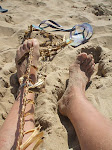Not every tetra pak has a silver lining, but those for milk do and are useful for Christmas decorations.
These tetra stars cost nothing to make, require no toxic glitter sprays or glues and the only child labour involved will, hopefully, be that of your own children! Northern Europe, America, Scandinavia and Japan are the most commonly claimed locations for the origin of these decorations. It doesn’t really matter where they originated, but in the making of them there is weaving as you might find on baskets all over the world. There is also a whiff of origami and surface decoration curls that often feature on south East Asian and Native American baskets.
You will need 4 strips of tetra pak 2cm wide and 55cm long. To get strips long enough from a one litre carton you will have to cut off the top and bottom of the carton, open it out into a cylinder and cut spirally. Start with a taper and gradually widen it until it measures 2cm.
You can do this free hand but here are a couple of films that might help. The first one shows you how to make a simple tool for cutting strips to an even width and the second how to use the tool to cut strips for weaving.
Weave the four strips together, silver side up, making sure the weaving is in the centre of the strips so that all the free ends are the same length.
Now do a “scooby doo” folding the four strips that are underneath forwards, in turn, over themselves and thread the last end under the first. The pictures show the 1st, 2nd and in the last one the 3rd and 4th moves together.
The printed side of the carton is now showing and all the strips are in pairs.
Turn the weaving over and repeat the action with the 4 strips that are on the top of each pair.
You now have all the strips spread out again.
With the silver side up, look at the edges of the woven square and you will see that half of the strips are behind just one layer of carton and half are behind a folded edge. Using the ones behind the single layer (they may be on the right or on the left of each pair depending on how you wove the initial square) fold the strip out to the side at an angle of 45degrees.
Then take the same strip around the back then forward to the front over the angled part and thread it down under the single layer of carton.
Do the same with the other three ends that are underneath the single layer of card. You may need to cut points on the end of the strips to help with the threading.
Turn over and repeat the action on the other side, again using the strips that are under the single layer.
You will now have eight strips spread out.
On the silver side take one of the free ends that are on top and lift it up into a loop. Now thread it from the centre of the weaving towards the outside and under the strip that it was previously lying on top of. Pull the end gently down until it really doesn’t want to go any more and pinch the two edges together at the centre and coax the other part into a cone shape.
Turn it over and do the same thing on the other side. Trim off the ends. If you want to hang the star, tie a loop of string with a single knot and push the loop up through the centre. You can gently pull the knot inside to hide it.
The variations are endless, not just with the size of strip but also the way in which it is started, the direction of the points and colour combinations. For the raised parts it is possible to make cones that don’t touch each other, which makes it more spiky looking. You can also make another set of points in between these…. but I will let you play....
There is a whole milky way of possibilities for you to discover.





















Hi Lois, I wish you a Merry Christmas and an Happy New Year. Thanks to share these stars.
ReplyDeleteHope you will have a healthy year full of nice projects and exhibitions.
Marie Faribault.
Thank you very much Marie. I wish the same for you and please let me know of any more exhibitions that you have.
DeleteLois
La rosa de Capdepera 'reciclada'! Buena idea.
ReplyDeleteThank you Carlos for drawing attention to the Catalan version. I did not personally notice, or make, one of these in Capdepera or I would have mentioned it. But I am not surprised to learn that these 'stars' or 'roses' are also made there because palm leaf is an ideal material to use for them.
ReplyDeleteI find your work so inspiring. Thank you. I am planning to attend on the Sunday of your course in Yell.
ReplyDeleteThank you Kester, I look forward to meeting you on Sunday.
ReplyDeleteLois